Importance of development team structure
The structure of a software development team can significantly impact the success or failure of a software project. A well-designed modern software development team structure can help ensure that the project is completed on time, within budget, and meets the expected quality standards.
Here are some of the key reasons why software development teams structure is important:
Collaboration
The structure of a software development team can help promote collaboration between team members. A well-structured team can help ensure that team members are working together effectively and communicating clearly with each other.
Efficient use of resources
The team structure can help ensure that resources, such as time and budget, are used efficiently. A well-structured team can help ensure that team members are assigned to tasks that align with their strengths, expertise, and availability.
Improved decision-making
A well-structured team can help ensure that decision-making is efficient and effective. A team with clearly defined roles and responsibilities can help ensure that decisions are made by the right people and are based on the best available information.
Quality control
A well-structured team can help ensure that the quality of the software is high. This can be achieved by assigning team members to roles that align with their expertise and experience, and by ensuring that the team follows established processes for quality control and testing.
Adaptability
The structure of a software development team can help ensure that the team is adaptable and can respond quickly to changing requirements or unexpected challenges. A well-structured team can help ensure that team members are able to adjust their roles and responsibilities as needed to address new challenges.
So, a well-structured software development team can help ensure that software projects are completed on time, within budget, and to the expected quality standards.
Approaches to structuring teams
There are several approaches to structuring software development teams, and the best approach will depend on the specific needs and goals of the organization. Here are some common approaches:
Functional Team Structure
This is a traditional approach where teams are organized by job function. Such team structure usually includes developers, testers, designers, and project managers. Each team member focuses on their specific area of expertise, and there is a clear hierarchy with managers overseeing each function
Cross-Functional Team Structure
In this approach, teams are composed of employees with different skill sets and expertise. The goal is to create a diverse team that can work collaboratively on projects and bring multiple perspectives to problem-solving.
DevOps Team Structure
DevOps is a methodology that combines development and operations teams to create a continuous delivery pipeline. DevOps teams are cross-functional and include developers, testers, and operations personnel. The goal is to streamline the development process and reduce the time it takes to release software.
Agile Team Structure
Agile methodology emphasizes flexibility and adaptability, and teams are structured to reflect this. Teams are usually small, with members from different functions working together closely. The focus is on collaboration, communication, and delivering working software quickly.
Ultimately, the best approach to structuring software development teams will depend on the business goals, the project's requirements, and the team's skills and expertise. It's important to regularly evaluate the team structure and make adjustments as needed to ensure the team is working efficiently and effectively.
Hiring a dedicated development team can give you tons of benefits. It is cost-effective, the team members are highly committed to your project, and you can directly communicate with each team member and, thus, manage the whole team.
Pros and Cons of each team structure
Functional Team Structure
Here are some potential pros and cons of using a functional team structure in software development:
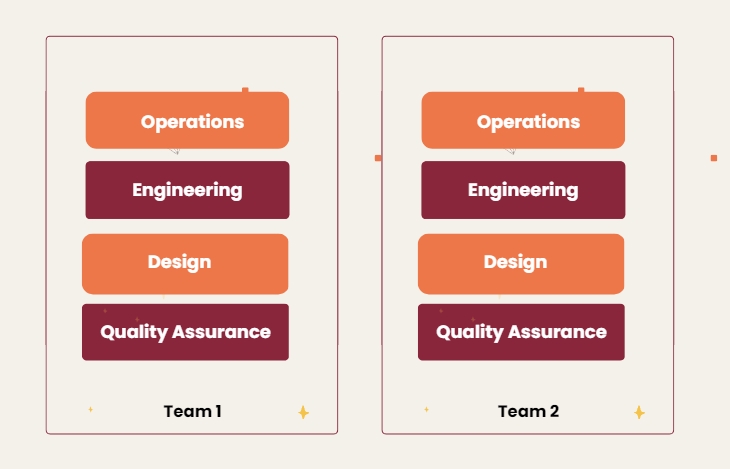
Pros:
Specialization
Each team member is focused on a specific function, which allows for greater depth of knowledge and expertise in their area of responsibility.
Collaboration
Team members work closely with one another, which can lead to increased collaboration and innovation.
Efficiency
This structure can lead to increased efficiency in completing tasks, as team members are able to focus on their specific areas of responsibility.
Training and development
The structure can support professional development and training programs, as team members can learn from one another and share best practices within their function.
Cons:
The major cons of this approach are:
Communication gaps
This structure may lead to communication gaps between functions, which can cause delays or misunderstandings in the development process.
Limited scope of responsibility
Team members may be limited in their ability to contribute outside of their functional area, which can lead to a lack of flexibility and adaptability in the development process.
Siloed mindset
This structure can sometimes lead to a "siloed" mindset, where team members are focused only on their specific function and may not have a broader understanding of the overall project goals and objectives.
Lack of ownership
Team members may feel less ownership over the final product, as they are only responsible for a specific part of the development process. This can lead to a lack of motivation and engagement.
Overall, the effectiveness of a functional team structure in software development will depend on the specific needs and goals of the project, as well as the communication and collaboration skills of the team members.
Cross-Functional Team Structure
Here are some pros and cons of this cross-functional team structure:
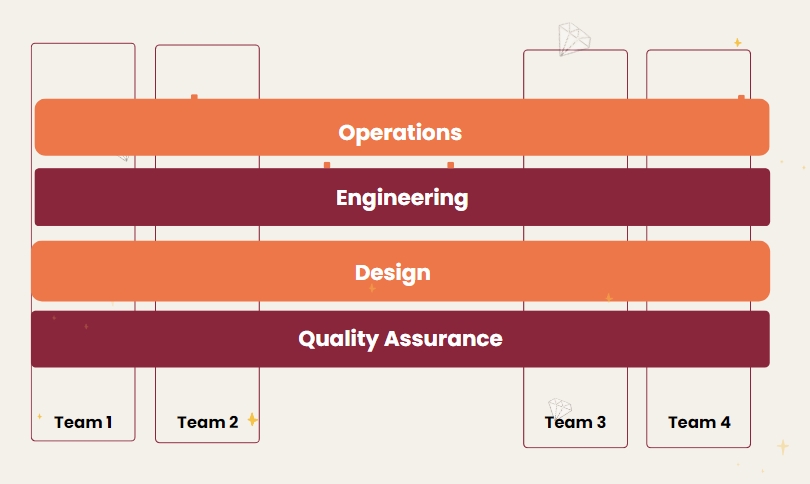
Pros:
Diverse skills and expertise
Cross-functional teams comprise members with different skill sets, knowledge, and experiences. This allows for a diverse set of perspectives to be brought to the development process. This diversity can lead to creative problem-solving and innovation.
Faster feedback loops
Cross-functional teams can enable faster feedback loops since they often work in close collaboration. This can help to identify and address issues early on in the development process, which can ultimately result in faster delivery times.
Increased accountability
Since cross-functional teams work towards a shared goal, team members tend to feel more accountable for the success of the project. This can lead to higher levels of commitment and ownership, which can improve the quality of the work produced.
Cons:
Communication challenges
Cross-functional teams can be challenging to manage since members come from different departments, backgrounds, and may have varying levels of experience. Effective communication can be difficult, and it may take time for team members to establish a common language and way of working.
Lack of expertise
While cross-functional teams have diverse skills and expertise, there may be a lack of deep domain knowledge in a particular area. This can lead to gaps in understanding and potential oversight of critical details.
Risk of conflicting priorities
Cross-functional teams often report to different managers, who may have conflicting priorities. This can lead to tension and disagreements over which projects to prioritize and how to allocate resources.
In conclusion, a cross-functional team structure can be beneficial for software development, but it is important to carefully consider the potential benefits and drawbacks before adopting this approach. Effective communication, management, and alignment of goals are crucial to the success of a cross-functional team.
DevOps Team Structure
This software engineering team structure aims to promote collaboration, increase agility, and improve the quality of software products. However, like any approach, there are both pros and cons to this team structure.
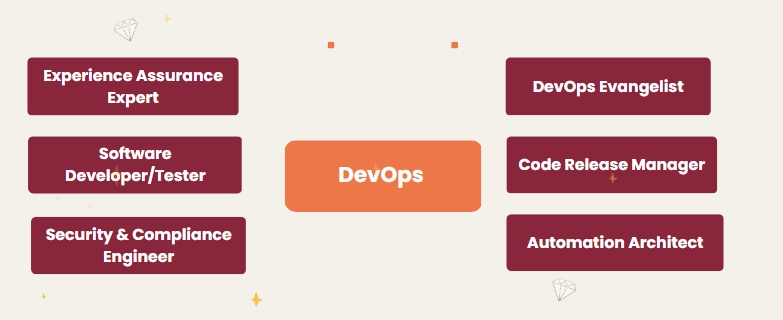
Pros:
Faster and more frequent software releases
The DevOps team structure enables faster and more frequent software releases by eliminating the traditional silos between development and operations. This results in a more streamlined and automated process for software delivery.
Better collaboration
By bringing together development and operations teams, DevOps promotes better communication, collaboration, and coordination across the entire software development lifecycle. This leads to a more integrated approach to software development.
Increased efficiency
DevOps automates many of the repetitive tasks involved in software development and deployment, such as testing, building, and deployment. This reduces the time and effort required to complete these tasks and increases the overall efficiency of the software development process.
Improved quality
DevOps emphasizes the use of automation and continuous testing to catch errors and defects early in the development process. This leads to a higher quality software product and fewer defects and bugs in production.
Cons:
Requires specialized skills
DevOps requires specialized skills, particularly in the areas of automation, continuous testing, and infrastructure management. Finding individuals with the right skills and experience can be difficult, particularly in a competitive job market.
Can be complex
The DevOps toolchain can be complex and difficult to manage, particularly for organizations that are new to DevOps. This can require significant investment in training and education to ensure that the team members are able to effectively use the tools.
Lack of ownership
The DevOps team structure can lead to a lack of ownership for specific tasks or components of the software development process. This can make it difficult to assign responsibility and accountability for specific tasks or issues that arise during development.
Agile Team Structure
Agile software development team structure specifics are that it’s usually highly collaborative and iterative. Here are some of the pros and cons of this team structure:
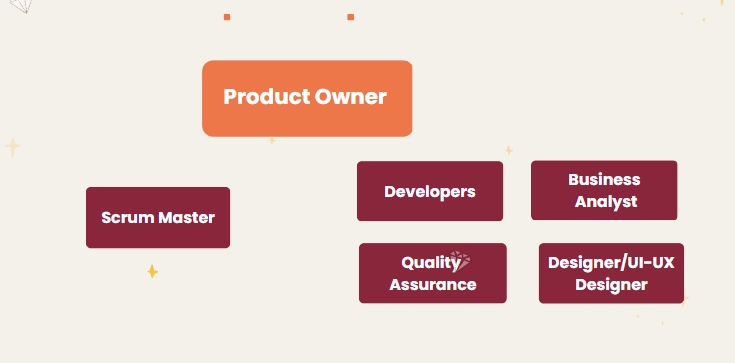
Pros:
Increased collaboration
Agile teams work closely together, which increases collaboration and communication among team members. This leads to faster problem-solving and improved productivity.
Flexibility
Agile teams are highly flexible and adaptable, which allows them to quickly respond to changes in project requirements or customer needs.
Faster delivery
Agile teams work in short iterations, allowing them to deliver working software quickly and incrementally.
Improved quality
Agile teams use continuous integration and testing to catch errors early, which leads to better quality software.
Better stakeholder engagement
Agile teams involve stakeholders throughout the development process, which leads to better engagement and more accurate feedback.
Cons:
Complex coordination
Agile teams require a high level of coordination and communication, which can be challenging to manage.
Difficult to scale
Agile teams are typically small and highly specialized, which can make it difficult to scale up for larger projects.
Lack of documentation
Agile teams often prioritize working software over documentation, which can make it difficult for new team members to understand the project.
Challenging for project scope
Agile teams work iteratively, which can make it challenging to manage project scope and avoid scope creep.
Overall, Agile software development has many advantages, but it may not be the best fit for all projects or teams. It requires a high level of coordination and communication, and it may not be ideal for large, complex projects.
Peculiarities of agile development team
Agile software development typically follows a team-based approach, where the team is self-organizing and cross-functional. The team structure can vary depending on the size and complexity of the project, but some common characteristics include:
Cross-functional team members
Agile teams are typically composed of cross-functional members with a variety of skills and expertise, such as developers, testers, designers, and business analysts. This allows the team to work together more effectively and to have a shared understanding of the project goals.
Small team size
Agile teams are usually small, with 5-9 members, to enable effective communication, collaboration, and decision-making.
Dedicated team
Agile teams are typically dedicated to a single project or product, allowing them to focus their efforts and build deep expertise in the domain.
Self-organizing
Agile teams are self-organizing, meaning that they are empowered to make decisions about how to best accomplish their goals. This requires a high level of trust and collaboration among team members.
Iterative development
Agile development is characterized by iterative development cycles, where the team delivers working software in short increments. This enables the team to receive feedback and make adjustments to the product quickly.
Continuous improvement
Agile teams are focused on continuous improvement and learning. This means that the team is regularly reflecting on their process and seeking ways to improve their efficiency and effectiveness.
Overall, the goal of an agile team structure is to enable fast, flexible, and collaborative software development that meets the needs of the customer.
Typical software development team structure
The typical software development team structure can vary depending on the size and complexity of the project, but here is a common example of typical software engineering team structure:
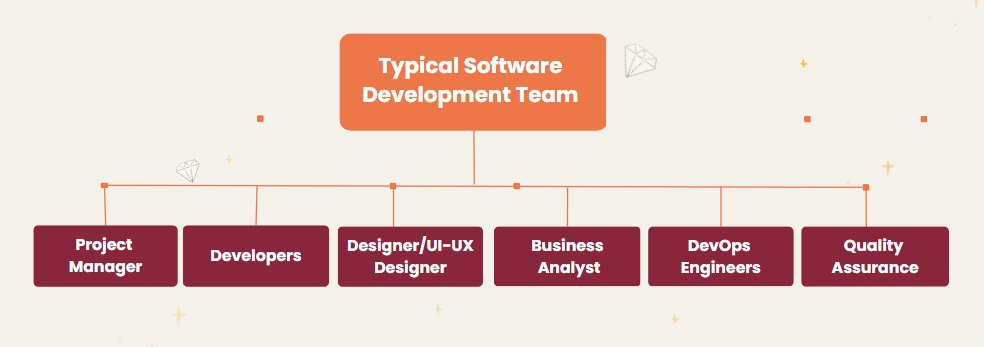
Developers
responsible for writing the code and implementing the software functionality, including front-end and back-end development.
Quality Assurance/Testers
responsible for testing the software to ensure it meets the functional and non-functional requirements, and identifying and reporting bugs to the development team.
DevOps Engineers
responsible for automating the deployment and testing process, maintaining the infrastructure, and ensuring the software is scalable and reliable.
Project Manager
responsible for overall project planning, scheduling, budgeting, and communication with stakeholders.
Business Analyst
works with stakeholders to gather and analyze requirements, and translates them into functional specifications for the development team.
Designer/UI-UX Designer
responsible for creating the visual and user interface design for the software.
Note that some teams may have more specialized roles, such as database administrators, security experts, or technical writers, depending on the project's needs.
Key roles in a software development team
Now let’s look more closely at the responsibilities within software engineering organizational structure
Developers
Among software development team members, developers play a crucial role, and their responsibilities typically include:
Writing and maintaining code
Developers are responsible for writing and maintaining the code that forms the foundation of software applications. They must ensure that the code is well-structured, efficient, and easy to read and maintain.
Designing software solutions
Developers work with the rest of the team to design software solutions that meet the needs of the business and end-users. This includes understanding requirements, identifying potential solutions, and developing prototypes.
Collaborating with other team members
Developers must work closely with other members of the software development team, including project managers, designers, and quality assurance testers. They must communicate effectively and collaborate to ensure that software is developed on-time and to a high standard.
Learning and adapting
Software development is constantly evolving, and developers must be willing to learn new technologies and adapt to changing requirements. They must stay up-to-date with the latest trends and best practices in their field to ensure that they are delivering high-quality software solutions.
Participating in code reviews
Developers participate in code reviews to ensure that the code they have written meets the team's quality standards. They must be willing to accept feedback and make changes as necessary to improve the quality of the code.
Documenting code and processes
Developers must document the code they write and the processes they use to ensure that the software is maintainable and understandable for other developers who may need to work on it in the future.
Quality Assurance/Testers
The key responsibilities of Quality Assurance/Testers in software engineering team structure typically include the following:
Testing
The primary responsibility of QA/Testers is to ensure that the software product is thoroughly tested and meets the required quality standards. They test software applications to identify bugs, defects, and other issues.
Test Planning
They are responsible for developing test plans, test cases, and test scripts to ensure comprehensive testing of the software product. This includes defining test objectives, test scope, test environment, and test data requirements.
Test Execution
QA/Testers execute test cases and document test results to ensure that the software product meets the expected quality standards. They use various testing tools and techniques to identify and report issues in the software.
Defect Management
QA/Testers are responsible for managing defects and issues identified during testing. This includes logging, tracking, and resolving defects in collaboration with developers and other stakeholders.
Continuous Improvement
QA/Testers play a crucial role in identifying areas for improvement in the software development process. They analyze testing results, provide feedback to the development team, and suggest process improvements to enhance software quality.
Collaboration
QA/Testers collaborate with developers, business analysts, project managers, and other stakeholders to ensure that the software product meets the requirements and quality standards. They participate in meetings and communicate testing progress, issues, and risks to the team.
Overall, the role of QA/Testers is critical in ensuring that software products are developed and delivered with the highest quality standards, meeting the requirements and expectations of the end-users.
DevOps Engineers
DevOps Engineers play a critical role in software development teams, as they are responsible for bridging the gap between development and operations teams. Their key responsibilities include:
Collaborating with cross-functional teams
DevOps Engineers work closely with software developers, quality assurance teams, and system administrators to ensure the smooth operation of software development and deployment processes.
Continuous integration and delivery
DevOps Engineers are responsible for setting up continuous integration and delivery (CI/CD) pipelines to automate the process of building, testing, and deploying code changes to production environments.
Infrastructure management
DevOps Engineers are responsible for managing the underlying infrastructure that supports software development and deployment. This includes setting up and maintaining servers, databases, networks, and other hardware and software resources.
Monitoring and logging
DevOps Engineers monitor software systems for performance issues, bugs, and other errors. They also set up logging and monitoring tools to help detect and diagnose problems as quickly as possible.
Security and compliance
DevOps Engineers are responsible for ensuring that software systems are secure and compliant with relevant regulations and industry standards. They must work closely with security teams to identify and address potential vulnerabilities and maintain compliance with applicable regulations.
Automation and scripting
DevOps Engineers use automation tools and scripting languages to streamline software development and deployment processes. This helps to reduce the potential for human error and speed up the time to market for software products.
Overall, DevOps Engineers are responsible for ensuring that software development and deployment processes run smoothly, efficiently, and securely. They play a critical role in helping organizations to deliver high-quality software products to market quickly and reliably.
Project Manager
As a Project Manager in a software development team structure, some of the key responsibilities include:
Project Planning
The project manager is responsible for creating a detailed project plan that includes the scope of the project, timeline, budget, resources required, and risk assessment.
Team Management
The project manager is responsible for managing the software development team and ensuring that everyone is working towards the common goal of delivering the project within the set timelines and budget. This includes assigning tasks, monitoring progress, and providing support where necessary.
Communication
The project manager must establish effective communication channels with stakeholders, team members, and clients to ensure everyone is aware of the project status, issues, and changes that may arise during the software development lifecycle.
Risk Management
The project manager is responsible for identifying, assessing, and managing risks that may affect the project's success. This includes developing contingency plans and mitigating any risks that may arise.
Budget and Resource Management
The project manager is responsible for managing the project budget and resources to ensure that the project is delivered within the set budget and utilizing the available resources effectively.
Project Reporting
The project manager must prepare regular project reports to provide stakeholders with an overview of the project status, progress, and any issues or risks that may affect the project's success.
Overall, the Project Manager plays a critical role in ensuring that the software development team delivers high-quality software products within the set timelines and budget.
Business Analyst
The primary responsibilities of a Business Analyst in a software development team are as follows:
Requirement gathering
BAs work closely with business stakeholders to understand their needs, problems, and goals. They collect, analyze, and document business requirements and convert them into technical requirements that developers can use to build software.
Analysis and problem-solving
BAs analyze business processes, data, and systems to identify problems and recommend solutions. They evaluate the impact of proposed changes and help stakeholders make informed decisions.
Communication and collaboration
BAs act as a liaison between business stakeholders and technical teams. They facilitate communication and collaboration among team members, ensuring that everyone is on the same page.
Documentation
BAs create and maintain project documentation, including requirements documents, functional specifications, user manuals, and other documentation as needed.
Project management
BAs work closely with project managers to plan, schedule, and track project activities. They help to identify risks and issues and recommend solutions to keep projects on track.
Overall, the role of a Business Analyst is to ensure that software development projects meet the needs of the business and deliver value to stakeholders. They are responsible for defining business requirements, communicating with stakeholders, and ensuring that software is delivered on time and within budget.
UX/UI designer
The key responsibilities of a UX/UI designer in a software development team are as follows:
Conduct user research
UX/UI designers need to understand the needs, preferences, and behaviors of users in order to create user-friendly interfaces. This involves conducting user research through surveys, interviews, and usability testing.
Design user interfaces
Based on the research conducted, UX/UI designers create wireframes, prototypes, and visual designs for software applications. They need to ensure that the interface is easy to use and aesthetically pleasing.
Collaborate with developers
UX/UI designers work closely with developers to ensure that the design is implemented correctly. They need to provide guidance on design decisions and review the code to ensure that the design is faithfully translated into the application.
Create design specifications
UX/UI designers need to document the design specifications to communicate the design requirements to developers. This includes creating style guides, design patterns, and interaction guidelines.
Test and evaluate designs
UX/UI designers need to test the designs to ensure that they meet user requirements and are functioning correctly. They also need to gather feedback from users and incorporate it into the design.
Stay up-to-date with design trends
UX/UI designers need to keep up with the latest design trends, tools, and techniques to ensure that their designs are relevant and effective.
How to determine the size of software development team structure
Determining the size of a software development team structure depends on various factors, such as the scope and complexity of the project, the development methodology being used, the available resources, and the expected timeline for project completion. Here are some guidelines to help determine the appropriate size of a software development team:
Project Scope
The larger the project scope, the more team members you may need. If the project requires multiple modules or features, it is advisable to have a larger team to manage the workload effectively.
Development Methodology
The development methodology being used can also affect the team size. For instance, an agile development methodology often relies on smaller teams of developers who work closely together to deliver iterative software releases. In contrast, a waterfall methodology typically requires a larger team to manage various stages of the development process.
Available Resources
Available resources, such as budget and equipment, can also affect team size. If the project budget is tight, it may be necessary to have a smaller team to manage the project efficiently.
Timeline for Completion
The expected timeline for project completion can also determine the team size. If the project needs to be completed within a short timeframe, a larger team may be necessary to ensure timely delivery.
In general, a software development team should be large enough to handle the workload effectively, but not too large that it becomes difficult to manage. A team size of around five to ten developers is often recommended for small to medium-sized projects. For larger projects, the team size may range from 10 to 50 developers, depending on the project's complexity and available resources.
Conclusion
In conclusion, the structure of a software development team is crucial for the success of any software project. The team structure should be tailored to the specific project requirements and goals, taking into consideration factors such as team size, team members' skills and expertise, communication and collaboration tools, and project management methodologies. Ultimately, the key to building a successful software development team structure is to prioritize effective communication, collaboration, and a focus on delivering high-quality software products that meet the needs of users.
you may also want to read

Leveraging Local LLMs and Secure Environments to Protect Sensitive Information
In the rapidly evolving digital landscape, businesses are increasingly adopting Generative AI (GenAI) technologies to stay competitive and innovate. Large...
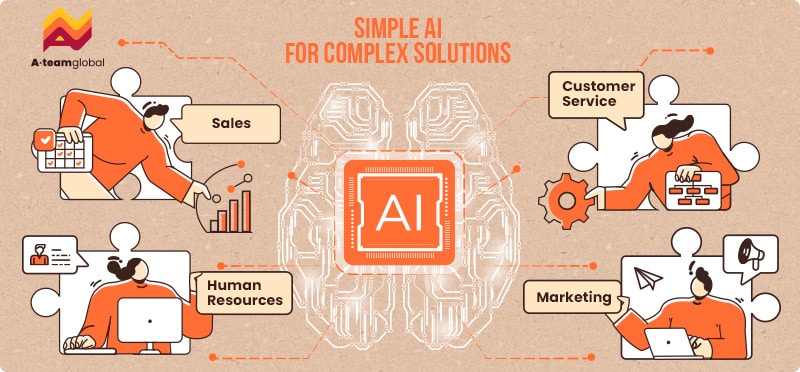
Boost Efficiency Today: Easy AI Integration for Immediate Results
In the past, the idea of integrating artificial intelligence into your business might have felt like venturing into uncharted territory—complex,...
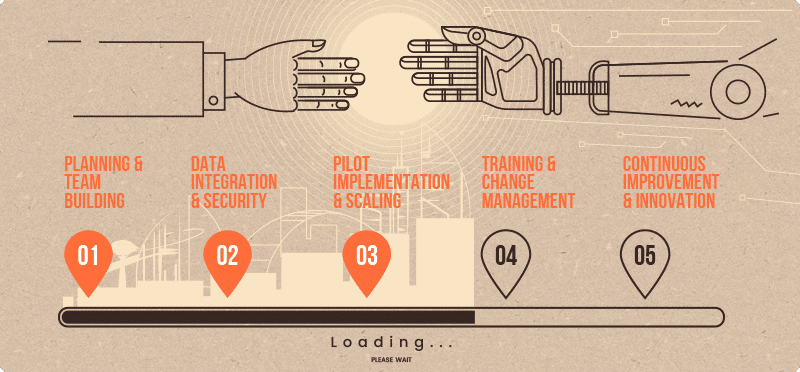
A Roadmap to Gen AI Adoption for Small and Medium Businesses
Unlock new opportunities by integrating Generative AI into your business operations. In today’s fast-paced digital landscape, small and medium businesses...
